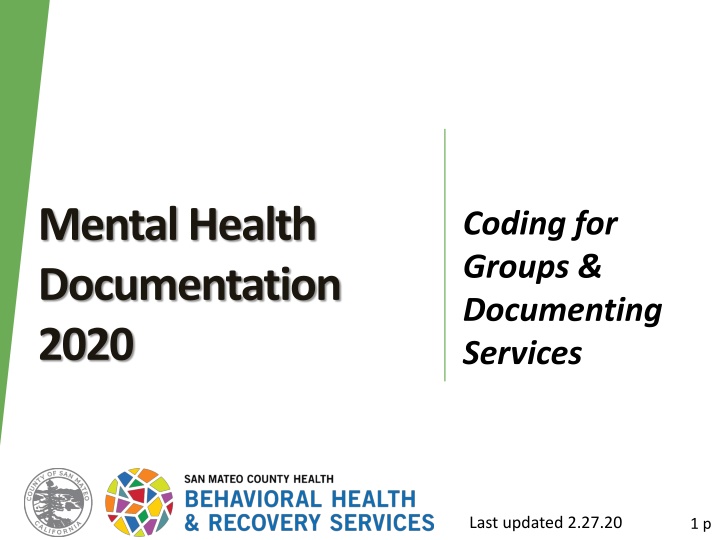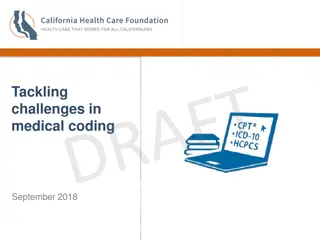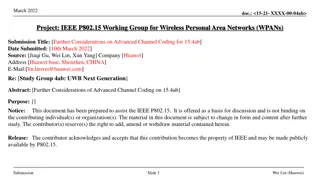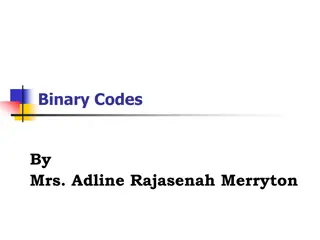Mental Health Documentation 2020: Coding and Group Services
This document outlines the coding requirements for mental health group services in 2020. It covers the important points to remember when documenting group interventions, details on the number of clients needed for a group, scenarios to determine correct client representation, unique group descriptions, and the relationship between groups and treatment plans.
Download Presentation

Please find below an Image/Link to download the presentation.
The content on the website is provided AS IS for your information and personal use only. It may not be sold, licensed, or shared on other websites without obtaining consent from the author.If you encounter any issues during the download, it is possible that the publisher has removed the file from their server.
You are allowed to download the files provided on this website for personal or commercial use, subject to the condition that they are used lawfully. All files are the property of their respective owners.
The content on the website is provided AS IS for your information and personal use only. It may not be sold, licensed, or shared on other websites without obtaining consent from the author.
E N D
Presentation Transcript
Mental Health Documentation 2020 Coding for Groups & Documenting Services Announcing New Group Code 550 Non-Billable Group Last updated 2.27.20 1 p
Group Notes: IMPORTANT POINTS TO REMEMBER You must document how YOU addressed the mental health condition with YOUR groupinterventions. Write what you did in that groupto address the mental health condition. 1. What YOU did Most of the content of a group note should be specific to the client s participation in that group on that day, and specific to You must document how YOU addressed the mental health condition with YOUR group interventions. Write what you did in that group to address the mental health condition. his or her diagnosis and how you addressed the client s mental health needs. 2. That GROUP that DAY To use a billable code, the note must show how the group service addressed the symptoms and/or functional impairments resulting from the client s mental health diagnosis, and how this is tied to the client s treatment plan. 3. Diagnosis & TREATMENT PLAN 2
How Many Clients Make a Group? 2 or more clients must be represented in a group, to code as a group. What counts as a Client Present or Represented: A client that has an open Episode in Avatar (chart/opening in Avatar). A client anywhere in the BHRS service of care may be open to a contractor. All members of the group must be current clients (or collaterals of current clients) of BHRS or of a contractor providing the service. A family member/significant support person(s) for an open client counts as 1 participant even if the client is in attendance (still counts as one). 3 PS
Scenario Which of these examples correctly details at least 4 clients represented in a group? Group 1: The client, her mother, mother s boyfriend, and the client s sister (4 group members?) Group 2: Two North County Adult clients and 2 clients from Caminar (the group is held at North County Adult- 4 clients?) Group 3: Four clients meeting at School-Based Services (4 group members?) Answer: Group 2 and 3 are correct, Group 1 is really Family Therapy or Collateral (Answer on slide 3) 4 PS
The Group Description Each group must have a unique description for that group, for that day. It is NOT sufficient to write ONLY a repeating blurb and copy and paste it group after group. 5
Groups and Treatment Plans No billable group should be provided prior to the treatment plan having been completed All billable groups require a treatment plan All group service codes must be added to the treatment plan prior to using a billable code 6 P-VR
In the following scenario Group Therapy is listed on my client s treatment plan. Group Rehabilitation is NOT listed as an intervention on the treatment plan. What should I do? Which of the following is correct? 1. I m providing group rehab. Group rehab is not listed on the treatment plan but that is OK because Group Therapy is listed. I ll use code 70 Group Rehab. If rehab group or any service that you are providing is missing, it should be added immediately with a Client Treatment Plan Addendum 2. I m a case manager. I don t see Group Rehab on the client s treatment plan but I don t need to worry about it and should just bill Group Rehab. Anyone can complete the Addendum; it just needs a co- signature if you are not an LPHA Group Therapy because it is on the treatment plan. 3. I m a clinician providing Group Therapy. I can go ahead and code this service You can coordinate with the primary clinician to determine who will add it 7 p-VR
Sometimes it is the role of the client and the role of provider that determines if a progress note is written and a service is coded. If your role if more of an educator or the group is more of a class or training not directly related to the mental health treatment plan, you don t need to write a progress note nor code the service. If the activity is a potluck or social event don t write a progress note and don t code the service. Only use billable codes for the parts of a group that are billable Code non-billable parts of a group 550 or non-billable time Billable groups are structured group activities, led by a provider, that address the mental health diagnosis and treatment plan goals of the client. There are groups that are not charted or billed. For example: socialization groups, community education focused groups (e.g. Mental Health First Aid, Parent Caf (in most cases), community outreach groups, groups in community setting open to the public. Groups that get charted/coded in a progress note are related to the Mental Health Treatment plan and Diagnosis. Every time a group of people get together (some clients) does not mean it gets charted in the medical record. Sometimes a gathering of people is just that and not a coded service. Coding Group Notes 8
You facilitate a group. In the group you watch a movie and eat lunch (2 hours). Scenario How would you code this Then talk as a group about mental health symptom management for 45 minutes. 75 minutes billable code face-to-face (45 minutes) + and other billable time (30 minutes- progress notes) = 75 minutes billable code, plus non-billable time = 120 minutes. service? Then spend 30 minutes writing progress notes. 75 minutes billable: face-to-face (45 minutes) and other billable time (30 minutes- progress notes). 9 P-S Non billable time (2 hour movie) = 120 minutes
Scenario You run a group that is open to all clients open to BHRS. You do not have a co-provider. Your group today included 9 participants, all BHRS clients. However, only 6 were open to your clinic and 3 of the clients were open to another county clinic. How many participants do you count in your progress note as attending the group and how many progress notes do you write? Count all 9 clients as participants in your progress notes and write one progress note for each client. For the 3 clients that are open to another BHRS County run clinics, write their progress notes under that program's episode. 10 P-VR
How do I CODE group progress notes? The amount of time coded is: Length of the group (face to face) + time spent writing the group progress notes (other) + any billable travel time (other), if applicable. Non-Billable activities are added to Other NON-Billable Service Time The time for each group needs to be divided evenly among all clients participating in the group, regardless of funding source. Avatar does this for you. Contractors need to make sure they are doing this. 11
Taking a NON-Billable Group and Making it Billable Hint, it is not just HOW you write the progress note, it is WHAT YOU DO IN THE GROUP 12
Not Billable Group leaders demonstrate how to do a perfect down dog, group members practice (550). Billable: Group leader demonstrates and teaches the group a series of yoga poses aimed at reducing anxiety. Group leader explains how yoga is useful coping technique to manage stress, anxiety and promote relaxation. Group leader later facilitates a discussion about how the group can utilize these poses in their daily life to manage symptoms of anxiety. 13
Not Billable Family gathering or gathering of clients with staff to share potluck (550). Billable: Group leader facilitates end of group potluck (potluck time in not billed- coded Non-Billable).Group members share what has been most helpful to them in the group. Each member shares 2 skills that they will continue to utilize to help manage symptoms of anxiety and how they can maintain their access to positive supports after the group ends. 14
NON-Billable Code 550 The group today focused on an art project. All group members painted whatever they wanted. The group leader demonstrated painting techniques. The goal of the group was to improve art skills to improve self esteem. The client was able to complete the art project. This group leader gave the client guidance around color selection and painting techniques. 15
Code: Rehab Group 70 The group today focused on expressing feelings related to depression. The facilitator shared ideas about how different people might express depression. Clients shared their personal feelings and rated their current level of depression (1-10 scale). Some group members had difficultly putting their feelings into words. An art expression exercise was utilized to facilitate clients exploration of their feelings all painted how they felt about their depression today. The group talked about their drawings and feelings and one thing they could do for themselves to feel 1 point better today. Jane actively participated in the group. She reported a 6 on a scale of 10 as her current depression level. She identified playing with her dog when she got home today as her self-care to improve her general well-being. A co-provider was utilized in the group today to share ideas about how to practice self-care and assisted with facilitation and breakout sessions. 16
What made it billable? Both activities were similar. What made the second billable? Focusing on the mental health interventions (not the artwork) Rating current feelings Identifying self-care techniques Taking the art project to a clinical level 17
Deeper Dive into Billable vs Non- Billable Group Activities How do I Code This? 18
Billable vs Non Billable Groups Billable Group Codes Group Collateral: Multi-family groups to support family members/significant support persons of clients code (120). All staff can use this code Group Rehabilitation: Groups focused on psychosocial rehabilitation code(70) All staff can use this code Group Therapy: Groups providing therapy and focused primarily on symptom reduction in order to minimize functional impairments code (10). LPHA_ Therapy Interns only Medication Support Groups: Groups providing medication support services code (150). Related to mental health not physical health. RN/MD/OD/NP only Non-Billable Codes: 550 Unbillable Services. All staff can use this code 19
Billable vs NON-Billable NON-Billable Time (550) AOD only Billable Time Eating lunch Immigration Issues Always addresses the mental health billable diagnosis Watching movies Preparation and/or setup for a group AND Driving to pick up clients for the group and bringing them back to the clinic The Group Service is listed on the TREATMENT PLAN Cooking demonstration/cooking practice Museum or other community outing Shopping Arts/crafts projects Playing games/play time that does not have therapeutic focus Potlucks/Parties/holiday parties and holiday decorating Walking group or other leisure activities Taking clients to the Food Pantry Groups on nutrition and weight loss, smoking cessation 20
Are all groups billable? NO Groups that are NOT billable: Social or unstructured activity such as eating lunch, watching a movie, or going for a walk. To make it BILLABLE Add social skills training or mental health skill building exercise, make sure to link it to the diagnosis and treatment plan, and then you can use a billable code, usually Group Rehabilitation (70). 21
Dual-Diagnosis Groups If a Dual-Diagnosis Group focuses only on clients substance use recovery issues, the group should be billed (550) Unclaimable Service. For a dual-diagnosis client, whenever a group or other service addresses only AOD, the correct service code is (550) Unclaimable Service. To make it BILLABLE Address both the client s mental health condition and substance abuse. Have the co-occurring goal on the treatment plan and relate it to the Mental Health Billable Diagnosis. 22
Examples of Billable Group Activities List of BILLABLE Group Activities (billable as 70 or 10) Conversation practice/learning reciprocal communication skills, learning to read social cues accurately Practicing following directions that requires socially appropriate skills like turn taking, patience, frustration tolerance. Giving group feedback -requires group coaching and feedback to be billable. Role playing how to engage with peers at school Group leaders ask clients to rate their current mood and report on what has worked/not worked during the past week to reduce depression. Group leader offers training in coping skills development to address anxiety. Clients share their experience of the training and how they plan to implement coping skills. Watch a show or movie (non-billable) but then engage the group in a discussion about the themes of loss and depression portrayed in the movie (billable) Self-esteem group for girls-provider leads empowerment exercises, e.g.make lists of positive statements about self and share something positive about others in the group 23
Group Collateral (120) The number of participants that a progress note is written for equals the number of clients represented. For example: Client A and her parents attended the group. Client B did not attend, but his parents did. Two clients were represented, so two notes are written and the number of participants is two. 24
Scenario Your program offers a family support group that 7 parents attend for 4 open clients (their children). The group centers around eating a potluck dinner together. Family members bring food and share. Your program provides babysitting in the next room so the adults can spend some time together getting to know each other. How is this billed? How many progress notes do you write? This is not billable. There were no mental health interventions, the clients mental health issues were not addressed, and there were no client or care- related issues addressed to document in the chart. 25 P_S
Billing with MD and LCSW-Question What code would be used if the group was led by an MD and an LCSW, and the group addressed behavioral management and mental health symptoms? Bill Therapy Group (10) for two providers. Therapy Group is correct because it is within each provider's scope of practice and covers the main focus of the group. Either provider may write the notes and include both as providers. 27 P-VR
Billing with MD and LCSW-Question If a group really was just Medication Support and the LCSW was a support person, only the MD could bill Medication Support and write the group notes. The LCSW would not bill. 28
Co-Providers Scope of Practice Co-Providers bill for a group by writing a progress note or being a co-provider on a progress note. To bill for a group, each group provider must be eligible to bill for the service type. That is, if the group is Therapy, all group co- providers that are billed for must be able to provide therapy. 29
Group Progress Notes Facts Only one progress note is written for each client even if two staff lead the group. One staff writes and signs/finalizes the note. 30
Co-Providers Service Time Different amounts of time may be billed for each group leader. For example, One provider participates in the group for 50 minutes (bills/codes 50 min) The other provider participated for 50 minutes and spent 34 minutes writing progress notes (bills/codes 84 minutes) 31
Scenario If a group has 3 staff (providers) running a 65- minute therapy group, how many staff are billed/coded as a co-provider for the group? 2 staff (providers) and 1 progress note is written for each client. (Just note in the narrative that a third provider was present.) 32 P-VR
Co-Providers Progress notes must justify why two providers were needed Justification must be based on the clients needs, not the clinicians needs. Explain unique role that each provider played in provision of service. It is insufficient to write only a general statement like Co-provider monitored and addressed individual group dynamics and managed the group milieu, responding to individual client needs, concerns and goals. You MUST also include how the co-provider monitored, addressed and/or responded to the client s behavior in each unique session (i.e. interventions based on what the client brought to the group session that day). 33
Co-Providers Do all groups need multiple providers? NO. Many groups may need only one provider. If an intern is present solely to observe/"shadow" in order to learn how to facilitate a group, do not bill for the intern. If the intern is co-facilitating the group (and they meet requirements to provide that service), their co-provider service is billable. 34
Scenario A group has six clients and runs 70 minutes. Each client left the group for 10 minutes for a med injection with an RN who wrote his own notes for the injection. What would the group length be and how many providers are there? 70 minutes + documentation time, 1 provider It is the staff person's time that determines the length of the group. As long as each client attended most of the group s/he is counted for the full length. 35 P-VR
Information About Services and Sample Progress Notes 36
Group Collateral (120) Focus on skills development for parents or other significant support persons to address the client s mental health condition. Collateral services Provide a multi-family focus that enhances the families' ability to address the clients mental health needs Clients may or may not be present Group Collateral Activities Include: Addressing the client s mental health issues with support person(s) Parenting training to the support person(s) related to the client's mental health issues Psycho-education to the support person(s) concerning mental health issues 37
Sample Group Collateral (120) Note Goal/Objective: Psychoeducation for parents of children diagnosed with ADHD. I:Today s group focused on medications utilized for children with ADHD, in conjunction with behavioral interventions. Family Partner invited caregivers to share questions and concerns. R: Client s parents raised concerns and fears of putting him on medication. Counselor led a discussion regarding the pros and cons of medication. Normalized client s parents fears of ADHD medications. Encouraged the parents to meet with the psychiatrist to discuss further. Developed a list of questions to ask MD. P: Family Partner will update clinical team about client s progress. 38
Group Rehabilitation "Rehab" (70) Group Rehabilitation (70) is focused on psychosocial education. Rehab groups include healthy living, skills building, and behavior management groups. Rehab Group Activities Include: Addressing mental health goals Addressing physical health impact on mental health symptoms Coping skills training Daily living skills training Social skills training Rehabilitation Group Progress Notes include: Purpose of group (e.g. Purpose of group is to assist client in improving social skills) Client presentation/behavior Mental health interventions utilized Client s response to interventions Follow-up Plan (if indicated). 39
Sample Group Rehab (70) Note Goal/Objective: Clients will learn to manage stress associated with living with a mental health disorder. B: Client presented as disheveled with poor hygiene and soiled clothes. He reported feeling very stressed due to an ongoing conflict with his roommate. I: Counselor led the group in a meditation exercise, and explained the psychological and physical benefits of meditation and other relaxation techniques. Clients talked about their current level of stress before and after the exercise. R: Client responded well to the meditation exercise, saying he felt better. However, he expressed skepticism that he can do it on his own. Encouraged him to set aside a few minutes a day. He agreed to try. 40
Not Billable Christmas tree decorating group (550) Billable: Facilitator encourages members to share past experiences of the holidays, anxieties about the upcoming holidays, and leads a discussion on coping strategies (10 or 70) 41
Not Billable Group focuses on talking about favorite hobbies (550). Group leader facilitates a discussion about favorite hobbies due to the holiday season causing many members of the group to experience symptoms of depression. Discussion is focused on each group member identifying 1 hobby that they can engage in to help alleviate depressive symptoms. 42
Group Therapy (10) Group Therapy (10) provides therapy in a group setting that is focused primarily on symptom reduction in order to minimize functional impairments resulting from an included mental health diagnosis. Progress Note for Group Therapy includes: Purpose of group (e.g. Purpose of group is to assist client in learning and practicing coping skills to manage symptoms of PTSD) Behavior/Mental Status/Presentation (client appeared/reported) Mental Health Interventions utilized Client's Response Follow-up Plan (if indicated) Only Licensed/Registered/Waivered staff and trainees or RNs with Master s in Psych/Mental Health may provide therapy. 43
Sample Group Therapy (10) Note Goals/Objectives: Clients will manage symptoms related to the diagnosis of Bipolar Disorder. Two providers were required due to the possibility of group members getting dysregulated, to maintain a safe environment for all. B: Client appeared to be in a euthymic mood as evidenced by coming into group quietly and finding a seat. I: Therapist utilized CBT and interpersonal approaches to identify and encourage the use of positive coping skills. Clients checked in and reported the challenges they faced in the previous week, and the coping strategies used to manage them. Co-provider redirected clients who were getting off-topic and disruptive. When client shared about her week, therapist normalized the difficulty of using coping skills when feeling escalated and how practice was necessary to becoming adept at utilizing them. Co-provider assisted client in processing alternatives to how she would handle a similar situation in the future. R:Client s response: Client shared having had a difficult interaction with her mother last week. She felt upset that she got angry and disrespectful instead of utilizing her coping skills. She was receptive to therapist s and co-provider s feedback and engaged in discussing alternative ways to handle future upsetting interactions. 44
Medication Support Groups (150) Medication Support Groups (150) use the same general rules described in the "Group Progress Note" section. For medication support groups, the group leader and co-providers must be medical staff in order to bill for the service. Medication Support (150) Service Activities Include: Addressing psychiatric symptoms/medication Treatment Plan development with med support Evaluation of medication side effects/effectiveness Medication education Medication evaluation Obtaining Informed Consent for medications Addressing health issues impacted by psychotropic medications or functional impairments 45
Co-Providers Examples of how to justify a co-provider: Due to unsafe behavior of several clients in group today, two providers were required to maintain safety of all participants. Both practitioners were needed, due to dysregulation of some clients in the group, to remove/re-direct specific clients within group to maintain safety of all clients in group. Due to EBP requirements, two providers were needed to provide DBT group. Co-provider monitored and addressed individual group dynamics and cooperated to manage the group milieu and respond to individual client needs, concerns and goals. 46
Questions 47























